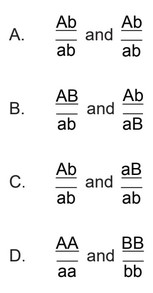Question
Black, short-haired guinea pigs, heterozygous for both characteristics, were crossed. They produced offspring with the phenotypes black short-haired, black long-haired, white short-haired and white long-haired in the ratio 9:3:3:1. A different cross produced offspring with phenotypes in the ratio $1: 1: 1: 1$. What were the genotypes of the parents in the second cross?
A. $\mathrm{BbSs} \times \mathrm{BbSs}$
B. $\mathrm{BBSs} \times \mathrm{BbSS}$
C. $\mathrm{BbSs} \times$ bbss
D. $\mathrm{bbSS} \times \mathrm{BBsS}$
Answer/Explanation
Ans:C
Question
An individual is heterozygous for two linked genes \(\frac{AB}{ab}\)
To investigate the frequency of crossing over, a test cross is carried out between the individual and
another that is homozygous recessive for both genes. What are the possible recombinants in the
offspring of this cross?
Answer/Explanation
Ans: C
Question
William Bateson and Reginald Punnett used the sweet pea (Lathyrus odoratus) in genetics studies in the early 20th century. Pure-breeding plants that produced purple flowers and long pollen grains were crossed with pure-breeding plants that produced red flowers and round pollen grains.
The resulting offspring all produced purple flowers and long pollen grains. Two of the F1 generation plants were crossed.
The table shows the ratio of phenotypes in the F2 generation.
Flower colour | Pollen grain shape | Number of plants |
purple | long | 4831 |
purple | round | 390 |
red | long | 393 |
red | round | 1138 |
What is an explanation for these experimental results?
Purple flowers and long pollen grains are dominant and the alleles have assorted independently.
The genes for flower colour and pollen shape are linked and all plants producing long pollen grains are recombinants.
The genes for flower colour and pollen shape are linked and all plants producing red flowers are recombinants.
Plants producing purple flowers and round pollen grains arose through crossing over.
Answer/Explanation
Ans: D